In today’s digital age, data is everywhere. From the websites we visit to the products we purchase, every click and interaction generates data. This abundance of data has led to the rise of data science, a multidisciplinary field that combines statistics, programming, and domain expertise to extract valuable insights and knowledge from data. In this beginner’s guide, we’ll explore the fundamentals of data science, its applications, and how you can embark on your journey into this exciting field.
What is Data Science?
Data science can be defined as the practice of using data to understand phenomena, make predictions, and drive decision-making. It encompasses a wide range of techniques, including statistical analysis, machine learning, data visualization, and more, to uncover patterns, trends, and relationships within data.
Applications of Data Science
Data science has applications across various industries and domains, including:
- Business and Marketing: Companies use data science to analyze customer behavior, optimize marketing campaigns, and forecast sales.
- Healthcare: Data science is used to analyze patient data, develop predictive models for disease diagnosis, and personalize treatment plans.
- Finance: Financial institutions leverage data science for fraud detection, risk assessment, and algorithmic trading.
- Technology: Tech companies use data science to improve user experience, develop recommendation systems, and enhance product functionality.
- Government and Public Policy: Governments use data science to analyze demographic data, optimize resource allocation, and inform policy decisions.
Key Concepts in Data Science
Before diving into the world of data science, it’s essential to understand some key concepts:
- Data: Data can be structured (organized in a specific format, like tables in a database) or unstructured (not organized in a predefined manner, like text documents or images).
- Data Cleaning and Preprocessing: Data often contains errors, missing values, and inconsistencies. Data cleaning and preprocessing involve transforming raw data into a clean, usable format for analysis.
- Exploratory Data Analysis (EDA): EDA involves visually exploring and summarizing data to understand its underlying patterns, distributions, and relationships.
- Statistical Analysis: Statistical techniques are used to quantify relationships within data, test hypotheses, and make predictions.
- Machine Learning: Machine learning algorithms enable computers to learn from data and make predictions or decisions without being explicitly programmed.
- Data Visualization: Data visualization techniques help communicate insights and findings effectively through charts, graphs, and interactive visualizations.
Getting Started with Data Science
If you’re interested in pursuing a career in data science, here are some steps to get started:
- Learn the Fundamentals: Start by gaining a solid understanding of statistics, programming languages like Python or R, and database management.
- Take Online Courses and Tutorials: There are numerous online courses and tutorials available on platforms like Coursera, Udemy, and DataCamp that cover various aspects of data science.
- Practice with Real-world Projects: Apply your knowledge by working on real-world data science projects. Kaggle competitions, open-source datasets, and personal projects are excellent ways to gain hands-on experience.
- Build a Portfolio: Create a portfolio showcasing your data science projects, including problem statements, methodologies, and results. A strong portfolio can help you stand out to potential employers.
- Network and Collaborate: Join data science communities, attend meetups, and collaborate with peers to learn from others and stay updated on industry trends.
- Stay Curious and Keep Learning: Data science is a rapidly evolving field, so it’s essential to stay curious, keep learning, and adapt to new technologies and techniques.
Conclusion
Data science offers exciting opportunities to uncover insights, solve complex problems, and drive innovation across various domains. Whether you’re a beginner exploring the basics or an experienced professional looking to advance your skills, the field of data science welcomes individuals with diverse backgrounds and interests. By mastering the fundamentals, gaining hands-on experience, and staying curious, you can embark on a rewarding journey into the world of data science.
Remember, the key to success in data science is continuous learning, experimentation, and a passion for discovering the stories hidden within data.
Happy analyzing!

